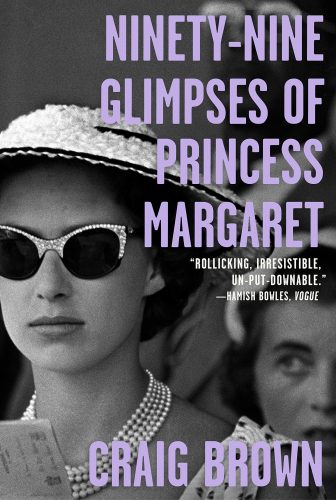Reflections in a Funhouse Mirror

Craig Brown’s Ninety-nine Glimpses of Princess Margaret was just one of the books discussed in this panel.
Amanda Vaill introduced the session by noting that traditional biographies often follow a linear narrative, with the narrator taking an omniscient distance from their subject. Vaill said that the three panelists—Craig Brown, Ash Carter, and Gilliam Gill—created “polyphonic, kaleidoscopic narratives, they just blow the roof off of biography.”
Vaill asked why each chose to take the approach they did. Brown, author of Ninety-Nine Glimpses of Princess Margaret and 150 Glimpses of the Beatles, said his first foray into non-traditional structure actually began with Hello, Goodbye, Hello, a “daisy chain” of encounters between famous people. “I’ve always liked this idea of having a pattern,” he said, rather than a strict chronological approach. That fueled the idea for offering short “glimpses” of Margaret and the Beatles. Each subject eventually turned up in the other’s book, with their paths crossing at the premiere of the Beatles film A Hard Day’s Night. Brown said that encounter proved to be “a pivotal event for Margaret and the Beatles . . . [a] moment when celebrity became like royalty . . . where their arc was going up, hers was going down.”
In terms of the structure for his Beatles book, Brown said that the decision to begin and end the book with Brian Epstein came late in the writing process. In the first glimpse, he meets the Beatles for the first time. In the last, Brown tells Epstein’s life in reverse, from his death in 1967 to that initial meeting. “I hoped it had some kind of emotional resonance,” Brown said, because the group’s meeting Epstein “begins the Beatles’ lives as Beatles,” but it was also “the beginning of Epstein’s death in a way,” as the meeting took Epstein out of a dull life and eventually propelled him into a world of drugs.
Gill took a new angle to present the life of her subject in Virginia Woolf: And the Women Who Shaped Her World, by focusing on the author’s influential female relatives. Gill began by noting that her background is in literary criticism, and she was somewhat forced into becoming a biographer at the behest of her editor, after Gill had written a series of critical essays on Agatha Christie, while the editor wanted a biographical approach.
With Woolf, Gill knew that several stellar biographies already existed, so she decided to look at the author’s relationships, including with relatives she never knew, such as her great-great-great grandmother, who “had Bengali blood, was a woman of color, which, to me, is tremendously interesting.” Other influential relatives included her sisters, and some beyond the nuclear family, including her French-Anglo-Indian maternal grandmother, Therese de L’Etang, and an aunt, Anne Thackeray Richie. Gill also said she wanted to tell the story of Woolf as someone who “fought valiantly since the age of 13 to stay alive and working,” not a victim who committed suicide. Gill said Woolf used writing to cope with sexual trauma she experienced as a child, and in her work Woolf came back often to how events in childhood affect people’s lives.
Turning to Ash Carter, Vaill noted that with the book on Mike Nichols, Carter and coauthor Sam Kashner chose a subject who had never been profiled in a soup-to-nuts biography, and the authors opted to write a “fugue of 150 voices” rather than go the cradle-to-grave route. Carter said the project actually started “as oral reminiscences” from 40 people who knew the improv comedian and director for an extended magazine piece. Carter said Nichols “does lend himself to this format” of oral reminiscence. It helped that Nichols had many famous, articulate friends. But Carter added there is “some difficulty in this format” because “you’re limited to the living.” Nichols lived a long life, dying at 83, which means that many who knew him when he was younger were now dead.
As Carter and Kashner’s original project grew beyond the 11,000-word magazine article, Carter said they worked with a belief that there “was something a little bit unknowable about him” that they could tease out. In structuring the book, “we felt we could pick and choose” among his great successes and failures. Along with the interviews they conducted, Carter and Kashner drew on interviews done for two PBS American Masters documentaries and books on Chicago’s Compass Theater to flesh out the book.
Because of its mostly oral-history format, the Nichols book was written with less of a feeling of the authors’ omniscience and resembled more of a mosaic (a term Brown also used in describing his Beatles book). Though, as one critic pointed out, Carter said, the mosaic metaphor is a bit misleading, since an artist carefully plans out a mosaic in advance. Relying on oral histories, Carter and Kashner didn’t really know what they would get or where they would end up. But they did know certain films would be the subject of their own chapters. While choosing quotes, Carter said, “you want each quote to lead to the next one . . . and you want it to seem like” the people are talking in the same room. You also “have to be a little bit creative” in cleaning up grammatical lapses and repetitions “while preserving [the interviewees’] cadences.”